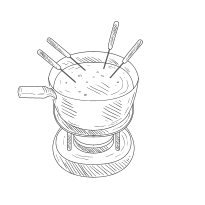How to Make Cheese Fondue: A Step-by-Step Guide to Melted Bliss
Few culinary experiences rival the sheer indulgence of cheese fondue. Imagine: a bubbling cauldron of perfectly melted cheese, its aroma filling the air, just begging to be swirled around crusty bread or crisp vegetables. It’s a dish that evokes warmth, conviviality, and pure cheesy delight, perfect for a cozy night in or a festive gathering.
While the thought of making cheese fondue at home might seem daunting, fear not! With this comprehensive guide, we’ll demystify the process and equip you with the knowledge and confidence to become a true fondue aficionado. From selecting the perfect cheese blend to achieving that coveted silky-smooth texture, we’ll cover all the essential tips and tricks.
The Keys to Fondue Success: Understanding the Science Behind the Melt
Before we delve into the specifics, let’s take a moment to appreciate the science behind a successful cheese fondue. The key lies in understanding the role of two critical components:
1. Cheese Selection: Embracing the Art of the Melt
The foundation of any exceptional fondue lies in the careful selection of cheeses. When choosing your cheesy companions, prioritize those known for their superior melting capabilities. Look for varieties that boast high moisture and fat content, as these characteristics contribute to a smooth and velvety texture when melted.
Here are some classic fondue cheeses renowned for their melting prowess:
- Gruyère: This Swiss cheese is a cornerstone of traditional fondue, prized for its nutty, slightly sweet flavor and exceptional melting properties.
- Emmental: Another Swiss classic, Emmental brings a mild, buttery flavor and excellent meltability to the mix, creating those signature fondue strings we all adore.
- Fontina: This Italian cheese contributes a subtle earthiness and a creamy texture, adding depth and richness to the fondue pot.
- Comté: Known for its complex, nuanced flavor, Comté melts beautifully, lending a luxurious touch to your fondue experience.
- Cheddar: While not a traditional choice, sharp cheddar can add a tangy twist to fondue. Opt for aged cheddar for a more intense flavor.
2. The Role of Acid: Keeping the Fondue Smooth and Stable
Adding an acidic element to your fondue serves a crucial purpose beyond simply enhancing flavor. Acids like dry white wine or lemon juice help break down the cheese proteins, preventing them from clumping together and ensuring a silky-smooth, homogenous fondue.
Essential Equipment for Fondue Mastery
To embark on your fondue-making adventure, you’ll need a few specialized tools to ensure optimal melting and serving:
- Fondue Pot: This essential piece of equipment is designed to maintain the perfect temperature for melting and serving fondue. Look for a pot with a sturdy base, even heat distribution, and adjustable temperature control.
- Fondue Forks: These long-stemmed forks are specially crafted for dipping bread and other goodies into the molten cheese. They typically feature two or three prongs to securely hold the food.
- Cutting Board and Knife: Use these to prepare your dipping ingredients, ensuring they’re an appropriate size for easy dipping.
- Heavy-Bottomed Saucepan: You’ll need this to melt the cheese mixture over low heat before transferring it to the fondue pot.
- Whisk or Wooden Spoon: Essential for stirring and incorporating the cheese as it melts.
Classic Cheese Fondue Recipe
Now that you understand the foundations of fondue mastery, let’s put your knowledge into practice with a classic cheese fondue recipe:
Ingredients:
- 1 cup dry white wine (such as Sauvignon Blanc or Pinot Grigio)
- 1 clove garlic, halved
- 1 tablespoon cornstarch
- 1/2 teaspoon Dijon mustard
- 1/4 teaspoon freshly grated nutmeg
- 1/8 teaspoon black pepper
- 12 ounces Gruyère cheese, shredded
- 12 ounces Emmental cheese, shredded
- Crusty bread, cut into bite-sized cubes, for dipping
- Steamed vegetables (broccoli, cauliflower, carrots), for dipping
- Apple slices, for dipping
Instructions:
- Prepare the Fondue Pot: Rub the inside of the fondue pot with the cut side of the garlic clove. Discard the garlic.
- Combine Wine and Cornstarch: In a small bowl, whisk together the wine and cornstarch until the cornstarch is completely dissolved.
- Melt the Cheese: In a heavy-bottomed saucepan, combine the wine mixture, mustard, nutmeg, and pepper. Heat over low heat, stirring constantly, until the mixture is smooth. Gradually add the shredded cheese, a handful at a time, stirring constantly until each addition is melted before adding more. Continue cooking and stirring until the cheese is completely melted and the mixture is smooth and creamy.
- Transfer to Fondue Pot: Carefully transfer the melted cheese mixture to the prepared fondue pot. Adjust the heat under the fondue pot to maintain a gentle simmer. Do not allow the fondue to boil.
- Serve and Enjoy: Arrange your dipping ingredients on a platter and gather around the fondue pot. Use the fondue forks to spear your chosen dippers and swirl them in the molten cheese. Enjoy the communal experience and savor every cheesy bite!
Tips for Fondue Perfection
- Shred Your Own Cheese: Pre-shredded cheese often contains cellulose, which can hinder smooth melting. Shredding your own cheese ensures optimal texture.
- Add Cheese Gradually: Adding the cheese in small batches, stirring constantly, allows it to melt evenly and prevents clumping.
- Low and Slow is Key: Melting the cheese over low heat and stirring constantly ensures a smooth and creamy fondue. High heat can cause the cheese to separate and become grainy.
- Don’t Overcook: Once the cheese is melted and the fondue is smooth, avoid overcooking. Prolonged heating can make the cheese rubbery.
- Adjust Consistency: If your fondue is too thick, you can thin it out with a splash of additional warmed wine. If it’s too thin, whisk together a teaspoon of cornstarch with a tablespoon of wine and stir it into the fondue.
- Get Creative with Dippers: While bread is a classic choice, don’t be afraid to experiment with a variety of dippers, such as steamed vegetables, roasted potatoes, cooked sausage, or even fruit.
- Embrace the Fondue Spirit: Fondue is more than just a meal; it’s a shared experience. Gather your loved ones, relax, and enjoy the convivial atmosphere as you dip, swirl, and savor the cheesy goodness together.
Exploring Fondue Variations: A World of Flavor Awaits
Once you’ve mastered the art of classic cheese fondue, a world of flavor possibilities opens up. Get adventurous with different cheese combinations, experiment with spices and herbs, or even venture into the realm of sweet fondue.
Troubleshooting Common Fondue Mishaps
Even seasoned fondue enthusiasts encounter the occasional hiccup. Here are some solutions to common fondue woes:
Fondue is Too Thick:
Gradually whisk in small amounts of warmed wine, a tablespoon at a time, until the desired consistency is reached.
Fondue is Too Thin:
In a separate bowl, whisk together a teaspoon of cornstarch with a tablespoon of warmed wine. Gradually drizzle the cornstarch mixture into the fondue, stirring constantly, until it thickens to your liking.
Fondue is Grainy or Separated:
This typically occurs when the cheese is heated too quickly or unevenly. Try removing the fondue from the heat source and vigorously whisking it to re-emulsify the cheese. If that doesn’t work, you can try adding a teaspoon of lemon juice to help break down the cheese proteins.
Fondue: A Culinary Adventure in Every Pot
Mastering the art of cheese fondue is a rewarding culinary endeavor. With the right ingredients, a little patience, and a dash of fondue spirit, you’ll be well on your way to creating memorable cheesy experiences that will have your guests clamoring for more. So gather your loved ones, fire up the fondue pot, and prepare to indulge in the ultimate cheesy celebration.

